#integral lars müller
Photo
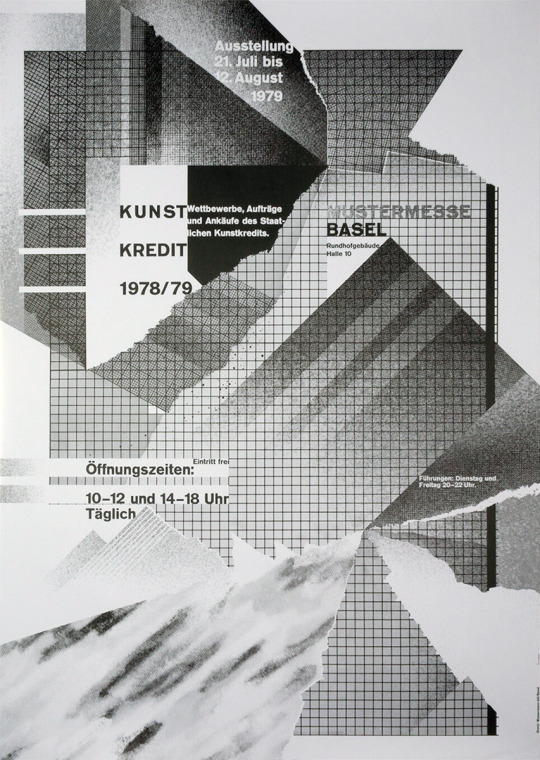
Wolfgang Weingart, Kunstkredit 1978/79, Mustermesse Basel, 1978 [Museum für Gestaltung Zürich. Flat & Bound, Integral Lars Müller, Zürich]
#graphic design#typography#exhibition#poster#wolfgang weingart#mustermesse basel#museum für gestaltung zürich#flat & bound#integral lars müller#1970s
83 notes
·
View notes
Text
Research - Lars Muller
Lars Müller was born in Oslo in 1955 and has been based in Switzerland since 1963. After becoming a graphic designer in Zurich and extended travels, he started a one-year assistant position with designer Wim Crouwel in Amsterdam. Having founded his own studio, Integral Lars Müller, in Baden (Switzerland) in 1982, Müller established a long-lasting friendship with his mentor Josef Müller-Brockmann. In 1983, Müller published his first book and, as Lars Müller Publishers, has produced some 600 titles to date.
Lars Müller is a passionate educator and has taught at various universities in Switzerland, Europe, the USA and Japan. In 2019, he taught as the Regents’ Professor at UCLA. Müller frequently serves on academic and competition juries. From 2009 to 2015 he was a member of the jury of Design Preis Schweiz and from 2013 to 2015 the international president of AGI Alliance Graphique Internationale.
https://www.lars-mueller-publishers.com/publisher
At AGI open, they had a library with discounted books for those who attended. I purchased 2 of Lars' books called "WHY WE DESIGN" and "Swiss Design". These books have inspired me to learn more about Swiss design as it has been something I am interested in. The minimalistic style of Swiss design is something I have always been drawn to. The way that people are able to communicate in a very basic yet very visually appealing ad aesthetic way.
His books give deeper meanings behind Swiss design and design in general. They show images of successful posters while also explaining the purpose and process of the designs.
0 notes
Photo

Need some utopia in your life? #Repost @50wattsbooks ・・・Dome overload from “R. Buckminster Fuller: Pattern-Thinking” by Daniel López-Pérez / 368-page paperback with flaps, 6.5 x 9.5 inches, hundreds of illustrations *** "Packed with illuminating archival illustrations, this deep dive into one of the 20th century’s greatest design-thinkers covers everything from his analysis of the cornea of the human eyeball to international economic structures." -- Christopher Knight ― Los Angeles Times "For Fuller, nature is the most exquisite technology we know; and what underlies all of his work is the quest to uncover nature’s fundamental principles--in order to foster their manifestation as a pattern integrity 'for successfully regenerating all life aboard our planetary spaceship.'" –Jaime Lawrence Snyder, Lars Müller Fuller Series Editor The work of R. Buckminster Fuller (1895–1983) is among the most extraordinary and inventive in 20th-century design and architecture, not least for its incorporation of a range of intellectual and technical disciplines. Fuller described himself as an “engineer, inventor, mathematician, architect, cartographer, philosopher, poet, cosmogonist, comprehensive designer and choreographer.'' R. Buckminster Fuller: Pattern-Thinking is a major reassessment of Fuller’s legacy in the context of design, examining his singular vision of new conceptual models for design and architecture, alongside his ideas on their potentially world-altering consequences. Drawing extensively on his archive and with over 300 images, the book follows Fuller’s explorations of geometry, language and intellectual property in their relation to design principles and pedagogy, organizing its survey of Fuller’s work through parallel conceptual threads rather than in a linear chronology of his career. https://www.instagram.com/p/CfgveFQOj0Z/?igshid=NGJjMDIxMWI=
0 notes
Photo

SHIPPING WORLDWIDE Programme as Typeface, Typography, Picture, Method Karl Gerstner: Designing Programmes Available at www.draw-down.com Designing Programmes is one of his most important and influential works. It was first published in 1964, and reissued in a new design by Lars Müller Publishers in 2007; both editions are now rare (the first almost completely unavailable). Across four essays, Gerstner provides a basic introduction to his design methodology and suggests a model for design in the early days of the computer era. Gerstner's innovation was to propose a rule set or system defined by the designer that would determine all aesthetic decisions for a given product: for example, a logo might also function as a layout grid system or inspire a font. Today the book is especially topical in the context of current developments in computational design. With many examples from the worlds of graphic and product design, music, architecture, and art, Designing Programmes inspires the reader to seize on the material, develop it further, and integrate it into his or her own work. #Typeface #Typography #Picture #Method #KarlGerstner #DesigningProgrammes (at Switzerland) https://www.instagram.com/p/B-67nVPHnBJ/?igshid=1hvhfgn7lj0pl
16 notes
·
View notes
Photo
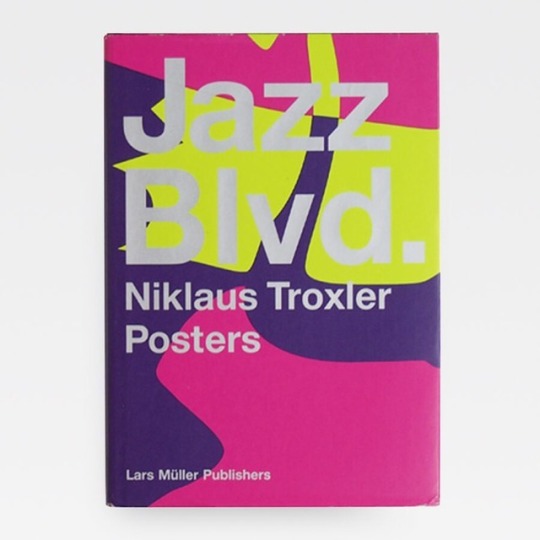
Jazz Blvd.: Niklaus Troxler Posters by @larsmullerpublishers / Design by Lars Müller Integral / Published by @larsmullerpublishers / Previously Available @pagespread * * * * * #niklaus #troxler #jazz #poster #posterdesign #jazzposter #design #graphicdesign #graphicdesigner #graphicbooks #books #book #bookdesign #booksondesign #graphicbooks #type #typography #typographic #typedesign #typeface #logo #logodesign #publication #publishing #grid #layout #designstudent #designstudio https://www.instagram.com/p/BtRvNIpB2iP/?utm_source=ig_tumblr_share&igshid=1aixzasajua1z
#niklaus#troxler#jazz#poster#posterdesign#jazzposter#design#graphicdesign#graphicdesigner#graphicbooks#books#book#bookdesign#booksondesign#type#typography#typographic#typedesign#typeface#logo#logodesign#publication#publishing#grid#layout#designstudent#designstudio
2 notes
·
View notes
Text
German NT preliminary squad: random facts/thoughts/stats
Clubs the players got called up from (17):
FC Bayern München (7 and a half)
Bayer 04 Leverkusen (3)
Manchester City (2)
Paris Saint Germain (2)
Real Madrid (1)
Barcelona (1)
FC Schalke 04 (1 but will join Bayern next season)
1. FC Köln (1)
Hertha BSC (1)
Borussia Mönchengöadbach (1)
Borussia Dortmund (1)
RB Leipzig (1)
SC Freiburg (1)
VfB Stuttgart (1)
Arsenal FC (1)
Chelsea FC (1)
Juventus Turin (1)
Surprising call ups:
Nils Petersen (SC Freiburg, debutant)
“Clutch” call ups:
Manuel Neuer (FC Bayern München, has been out all season due to injury - but in my opinion, he is undoubtful #1 and captain and will be needed regardless for motivational and experience reasons)
“Controversial” topics (through media, experts, etc.):
Sandro Wagner (FC Bayern München, was said to have cried and announced his retirement of the German NT, claiming that his “attitude of speaking my mind did not go well with the trainer team”, which resulted in a medial shitstorm between him and Joachim Löw.)
Mesut Özil & Ilkay Gündogan (after posing with Turkish president in London and handing over signed jerseys [to which Gündogan added “with due respect for my president”], a huge discussion emerged regarding supporting the controversial Turkish figure, the identification of players with migration background with the German NT and general integration issues in Germany.)
Players that were left out due to injury, lack of form, etc., but used to be regulars of the team:
Benedikt Höwedes (Juventus Turin)
Mario Götze (Borussia Dortmund)
Lars Stindl (Borussia Mönchengladbach, injury)
André Schürrle (Borussia Dortmund)
Emre Can (Liverpool, injury)
Shkodran Mustafi (Arsenal FC)
Sandro Wagner (FC Bayern München, see above)
Remaining World Champions (9):
Manuel Neuer (FC Bayern München)
Matthias Ginter (Borussia Mönchengladbach)
Mats Hummels (FC Bayern München)
Sami Khedira (Juventus Turin)
Mesut Özil (Arsenal FC)
Thomas Müller (FC Bayern München)
Julian Draxler (Paris Saint Germain)
Toni Kroos (Real Madrid)
Jérôme Boateng (FC Bayern München)
#my two cents#rant#die mannschaft#german nt#germany nt#call ups#preliminary squad#information#my lists#dfb#world cup 2018
57 notes
·
View notes
Photo
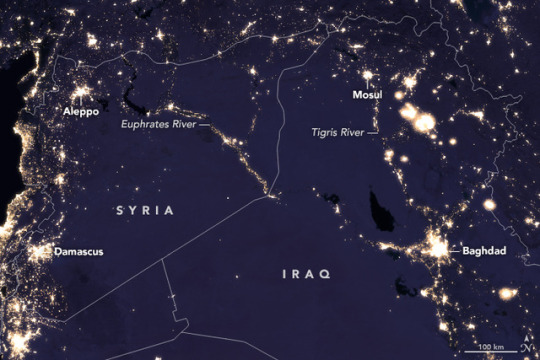
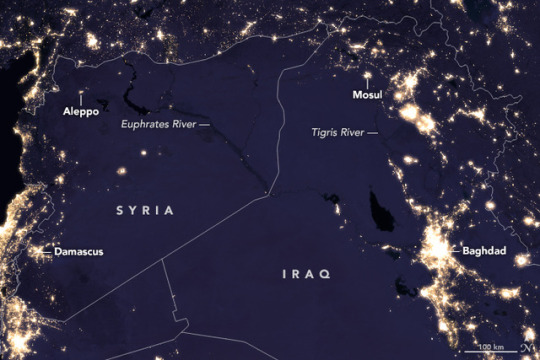
Night Lights Change in the Middle East
Unlike most satellite imagery and data, views of Earth at night tell a distinctly human story. From fires to fishing boats to urban neon, lights show where people have made their homes, set up their industries, and laid down their roads. The lack of light usually reflects rural or uninhabited areas, though sometimes it means there is not enough electricity to keep lights on through the night.
Changing patterns of light over time also tell us something. The images above show differences in nighttime lighting between 2012 and 2016 in Syria and Iraq, among several Middle Eastern countries. Such images interest demographers, engineers, and social scientists because they can indicate economic development or the lack of it. Some changes reflect increases or decreases in electric power generation or in the steadiness of the supply. Even areas that switch to LEDs or other energy efficient lights can show up over time.
Night light images also have value for international relief and humanitarian organizations, which can use this data to pinpoint areas in need. NASA makes its Earth observations freely and openly available (often via the Web) to those seeking solutions to important global issues. Several current applied sciences efforts within NASA are aimed at making satellite data more readily accessible for disaster response and the delivery of aid.
Each image above is drawn from a global composite that was made by selecting the best cloud-free nights in each month over each land mass on Earth. The data come from the Visible Infrared Imaging Radiometer Suite (VIIRS) on the NASA-NOAA Suomi NPP satellite. VIIRS includes a special “day/night band,” a low-light sensor that makes quantitative measurements of light emissions and reflections, allowing researchers to distinguish the intensity, types, and sources of night lights and to observe how they change over several years.
A research team led by Miguel Román of NASA’s Goddard Space Flight Center recently released new global maps of Earth at night from 2012 and 2016. Román and colleagues are collaborating with institutions such as the U.S. Federal Emergency Management Agency and the United Nations to enable near-real-time applications of such data, in addition to fundamental research.
In the images above, the changes are most dramatic around Aleppo, but also extend through western Syria to Damascus. Over the four years, lighting increased in areas north of the Syrian border in Turkey and to the west in Lebanon. According to a 2015 report from the Voice of America, as much as 80 percent of the lights have gone out in Syria over the past few years.
In Iraq, some northern sections near Mosul saw a decrease in light over the years, while areas around Baghdad, Irbil, and Kirkuk saw increases. Note, too, the change in electric light patterns along the Tigris and Euphrates river basins.
International agencies such as the United Nations Institute for Training and Research Operational Satellite Applications Programme (UNITAR-UNOSAT) have used such imagery in the past few years “to track fast-moving conflicts and to update our UN colleagues on where the front lines might be,” said Lars Bromley, a remote sensing specialist with the agency. UNOSAT works to “improve the integration of satellite imagery and geospatial data in supporting global UN operations and activities in the areas of disaster response, humanitarian support, human security, and human rights.” Nighttime imagery helps relief and peacekeeping groups identify areas that are most in need of aid and support.
To view and download images and stories of night light science, visit our Earth at Night page.
References and Related Reading
Román, M. O. and Stokes, E. C. (2015) Holidays in lights: Tracking cultural patterns in demand for energy services.Earth’s Future, 3, 182-205.
UN Institute for Training and Research Operational Satellite Applications Programme (2014, June 12) Visible Light at Night Over Syria Using the Visibile Infrared Imaging Radiometer Suite (VIIRS-Day/Night Band)—Analysis with VIIRS Data Acquired 01 May 2014 & 15 August 2012. Accessed May 9, 2017.
UN Institute for Training and Research Operational Satellite Applications Programme (2014, August 4) Visible Light at Night Iraq Syria Using the Visibile Infrared Imaging Radiometer Suite (VIIRS-Day/Night Band). Accessed May 9, 2017.
Voice of America (2015, March 12) War Has Left Syria in the Dark, Images Show. Accessed May 9, 2017.
ESRI (2017, April 28) Lights On, Lights Out. Accessed May 9, 2017.
Motherboard (2016, December 5) Syria’s River is Overflowing Now That Its People Have Fled. Accessed May 9, 2017.
Müller, M.F., et al. (2016) Impact of the Syrian refugee crisis on land use and transboundary freshwater resources.Proceedings of the National Academy of Sciences, 113 (52) 14932-14937.
Pew Research Center (2016, October 18) Conflicts in Syria, Iraq, and Yemen lead to millions of displaced migrants in the Middle East since 2005. Accessed May 9, 2017.
CIA World Factbook (2017) Middle East: Syria. Accessed May 9, 2017.
CIA World Factbook (2017) Middle East: Iraq. Accessed May 9, 2017.
NASA Earth Observatory images by Joshua Stevens, using Suomi NPP VIIRS data from Miguel Román, NASA GSFC. Story by Michael Carlowicz.
Instrument(s): Suomi NPP - VIIRS
11 notes
·
View notes
Photo
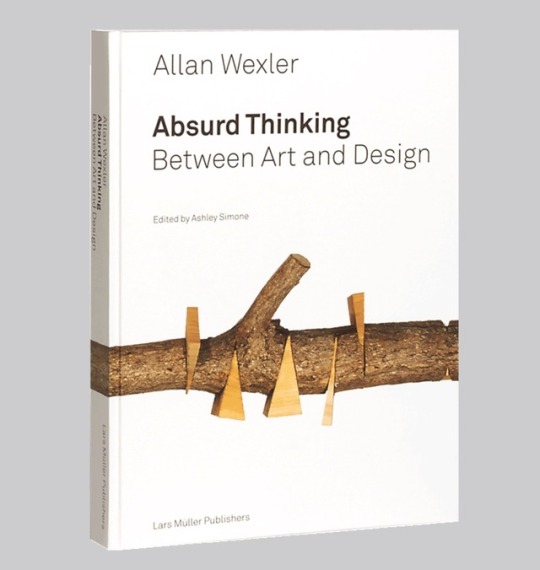
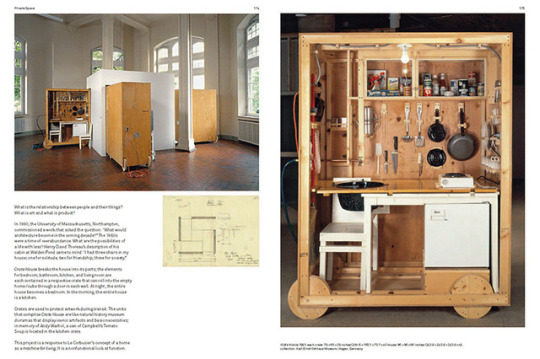

READY TO TAKE A BREAK FROM DRAWING LINES?
Allan Wexler: Absurd Thinking - Between Art and Design, published by Lars Müller, a Swiss publishing house with beautiful editions or art and architecture books.....https://www.lars-mueller-publishers.com
from archidose: http://archidose.blogspot.com
Covering 45 years of Allan's career – from his days as an architecture student at RISD and Pratt to the present – Absurd Thinking presents many, many projects in four thematic chapters: abstraction, landscape, private space, and public places. I would have assumed that works of interest to architects would be found in the last two chapters, but given Wexler's approach to each commission there is something architecturally appealing throughout. Take the tree branch pictured on the book's cover. Titled Reframing Nature, it started as a curved tree branch that he photographed, cut up, and then reconfigured into a straight branch; he then sawed and straightened the real thing with wood wedges. These wedges, or shims, are an integral part of any building project, and Wexler uses them in many of his pieces, all in surprising ways. The result may not look like architecture, but the thinking behind it and the means of its straightening get pretty close to the core of architecture: the fashioning of nature's raw materials into something organized for human use and pleasure.
_ik
0 notes
Text
Book Review: Allan Wexler: Absurd Thinking
Allan Wexler: Absurd Thinking-Between Art and Design edited by Ashley Simone "with the close collaboration of Ellen Wexler"
Lars Miller Publishers, 2017
Hardcover, 296 pages
I first became acquainted with the architectural art of Allan Wexler in 2009 – well, maybe it was earlier, but that was the first time I wrote about it on this blog. It seems that since then I come across his work, unawares, in a number of places I go. There's the Overlook in the LIRR Terminal in Brooklyn, which became part of my G Train walking tour upon discovering it while scouting the route. There are the easy-to-miss but hard-to-forget Two Too Large Tables in Hudson River Park at 29th Street. And how could I forget my first encounter with the Parsons Kitchen, which was pulled out for drinks following a crit some years ago. These are just a few of the many Wexler artworks found in the new monograph published by Lars Müller Publishers.
Wexler, who collaborates with his wife, Ellen, describes himself as "an architect in an artist's body." I'd buy that, given the qualities of the artworks I've been subjected to, such as the ones mentioned above and those on display at Ronald Feldman Fine Arts in 2014. What he/they produce can certainly be called art, though there is a clear predilection of architectural subjects: houses, stairs, fences, landscapes, and furniture, to name a few. Even when a chair, one of the most functional objects around, is a subject, it is maligned beyond function or sculpted in an unexpected manner, thereby pushing it into the realm of art. Of course, works like the Crate House (above) or the Parsons Kitchen confuse matters; they are compact yet highly functional pieces of equipment whose artistic merits are layered over their curious means of storage and use.
This isn't to say the Wexlers produce only architectural art. The Hat for Bottled Rainwater (above) is but one of many artworks that show their diversity of interests. Appearing to unite everything is the book's title, "absurd thinking." The hat is certainly absurd, though in many cases the absurdity is found in the process, not the end result. To put it another way, their absurd thinking is a way of considering the conditions for making art, conditions that for them are always contingent on place or space. This means that even the hat is arguably an architectural artwork, since it takes the human body as its site. Likewise, the Parsons Kitchen was made to fit into an awkward unused space next to an elevator, not just hold wine glasses and potato chips.
Covering 45 years of Allan's career – from his days as an architecture student at RISD and Pratt to the present – Absurd Thinking presents many, many projects in four thematic chapters: abstraction, landscape, private space, and public places. I would have assumed that works of interest to architects would be found in the last two chapters, but given Wexler's approach to each commission there is something architecturally appealing throughout. Take the tree branch pictured on the book's cover. Titled Reframing Nature, it started as a curved tree branch that he photographed, cut up, and then reconfigured into a straight branch; he then straightened the real thing with wood wedges. These wedges, or shims, are an integral part of any building project, and Wexler uses them in many of his pieces, all in surprising ways. The result may not look like architecture, but the thinking behind it and the means of its straightening get pretty close to the core of architecture: the fashioning of nature's raw materials into something organized for human use and pleasure.
from A Daily Dose of Architecture http://ift.tt/2rWoJr0
0 notes
Text
750 word reflective
The skills I’ve learnt over the past 3 years vary. I have improved knowledge of all aspects of the filmmaking process. This year pre-production was integral to the shoot; this is something that I learnt in the beginning of my time on the course. Without this knowledge I would have suffered during the shooting dates with the problems that occur on shoot. Storyboarding wasn’t something that came naturally to me; though through trying out different ways to create storyboards I have now found the right method for me. The storyboard for Inseminate was extensive and helped from production all the way through to the editing process with labelling shots.
As my filmmaking process usually revolves around getting to grips on all areas and aspects on the film. I feel my communication and people skills have benefitted greatly, meeting and auditioning actors helped with this; these are skills that will translate through multiple practices and is great skill to have for work placements.
These communication skills have ensured I can lead a project and a team, from planning through to the creative process and in to the editing suite. I have learnt what makes a good crew and how to manage them to create the best possible film; whilst also keeping everyone happy and satisfied. I feel as a team leader you should lead by example and always be professional.
My cinematography and camera knowledge before the course wasn’t extensive. Now as a cinematographer I feel I’m up to date with the latest technology. From simple framing rules like the Rule of thirds to the technical aspects of lighting and Kelvin settings on cameras. These skills ensure that whenever I film something the colour and images are of a professional standard. I feel my observational filmmaking techniques have improved greatly; I feel that I use the space around me very well. I feel this skill will be best used in documentary work.
This year; I researched heavily in to natural lighting. This has been at the forefront of my mind when considering lighting choices. Blue hour and the minutes in between in which the light changes to another shade every 10 seconds or so creates amazing images. The connotations and how you use this light in relation to the films subtext is important. This was heavily influenced by a number of practitioners such as Robby Müller, Lars Von Trier, Terrance Malick and Wim Wenders. This highlighted the importance of researching for me. Practice based research can take place any time not just within an educational institute. Researching and constantly renewing my practice with new techniques is something I have taught myself that I can do. This is necessary for every project I’ll undertake. Now I have experience doing this my future projects will benefit.
My future plans are to spend time in Manchester where I have spent the past 3 years making contacts and networks with people based here. I will work part-time for now to pay rent whilst also saving up for a new camera. This will ensure that I can keep developing and freelance to start and to earn. Hopefully when this takes of I’ll be able to freelance more and more. I have a work placements lined up in London for the summer. This will give me the industry experience that I need and this will hopefully lead on to future work and more prospects. I have contact with We Are Invite an independent production company based here in Manchester. The team of two will be looking to expand in the future and I have a foot in the door for any opportunities they may have. There is also an opportunity to direct and film a vignette as part of a series they will create. In which a number of local filmmakers from the north west will all film their own segment.
The MSA film festival is a great opportunity to have my work screened and shown to a large audience. I have begun using social media to market the film with a Facebook page. I have been sharing the poster around on social media using the collaborators of the project to share it around. I am confident that this entice people to come, with my social media being very personal. Word of mouth has also been a great way of marketing this film, many friends and contacts I have made over the passed 3 years have expressed their interest in the festival after talking to them about it. I feel that word of mouth and talking with people is the best way to market a film of this calibre.
0 notes
Photo
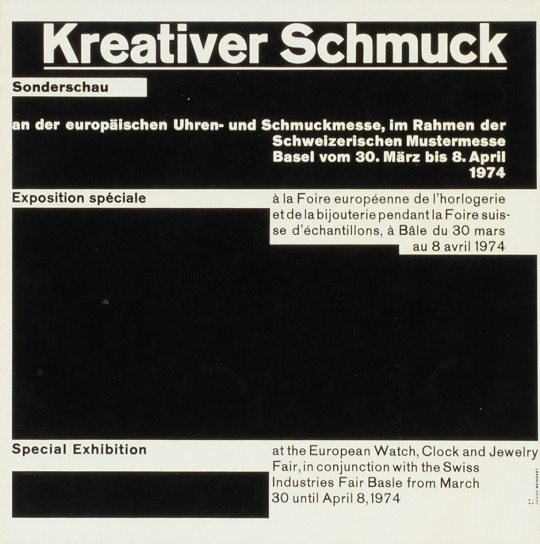
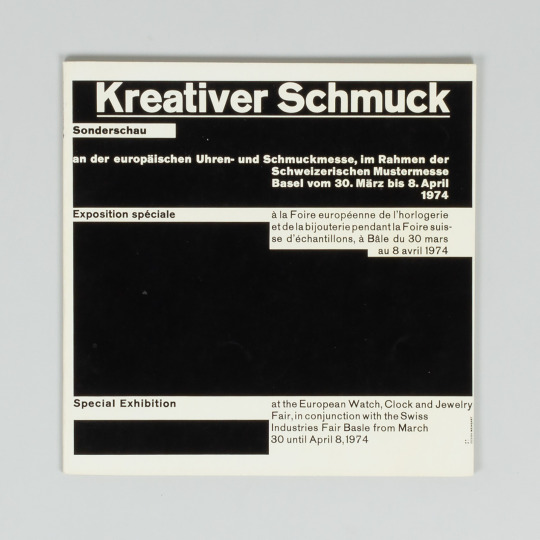
Wolfgang Weingart, Kreativer Schmuck, (exhibition catalogue), Mustermesse Basel, 1974 [Flat & Bound, Integral Lars Müller, Zürich]
#graphic design#typography#exhibition#catalogue#catalog#cover#wolfgang weingart#mustermesse basel#flat & bound#integral lars müller#1970s
73 notes
·
View notes
Video
youtube
What is ECOLOGICAL URBANISM? What does ECOLOGICAL URBANISM mean? ECOLOGICAL URBANISM meaning - ECOLOGICAL URBANISM definition - ECOLOGICAL URBANISM explanation. Source: Wikipedia.org article, adapted under http://ift.tt/yjiNZw license. The ecological urbanism project draws from ecology to inspire an urbanism that is more socially inclusive and sensitive to the environment, as well as less ideologically driven, than green urbanism or sustainable urbanism. In many ways, ecological urbanism is an evolution of, and a critique of, Landscape Urbanism arguing for a more holistic approach to the design and management of cities. The term appeared first in 1998 as "EcoUrbanism" in a book by Architect and Planner Miguel Ruano, who defined it as "the development of multi-dimensional sustainable human communities within harmonious and balanced built environments". The term was used later in April 2003 at a conference at the University of Oregon, and again in 2006 in a paper by Jeffrey Hou. The phrase was used by Mohsen Mostafavi in 2007 in Intervention Architecture and in a lecture at the Canadian Centre for Architecture, ecological urbanism as a project was largely started at Harvard University Graduate School of Design, with a conference, and exhibition, and book. Arguing for a "new ethics and aesthetics of the urban," the 656-page Ecological Urbanism book, edited by Mohsen Mostafavi with Gareth Doherty, was published in May 2010 by Lars Müller Publishers (ISBN 978-3-03778-189-0). The book follows the conference, and exhibition, held at the GSD in 2009. The book has a long list of contributors, including Rem Koolhaas, Homi K. Bhabha, Mitchell Joachim, Andrea Branzi, and about 130 others. A blog during the conference is part of the book. According to Architecture Today, the book is "one of the few books that recognises and articulates how, if this systems-based approach is to be successful, it needs to design, integrate and express complex systems and social processes in ways that are fundamentally humane." The book has been reviewed and cited in many publications, including , The Journal of Landscape Architecture, and Cities magazine. Events and discussions on the book have been held at the 2010 Venice Biennale, the Storefront for Art and Architecture in New York, and at the Van Alen Institute in New York. In his introduction to the Ecological Urbanism, "Why Ecological Urbanism? Why Now?", extracted in Topos: The International Review of Landscape Architecture and Urban Design, Mostafavi asks: "Increased numbers of people and cities go hand in hand with a greater exploitation of the world’s limited resources. Every year, more cities are feeling the devastating impacts of this situation. What are we to do? What means do we have as designers to address this challenging reality? Jeb Brugmann in his book Welcome to the Urban Revolution: How Cities Are Changing the World (Bloomsbury Press, 2009) says we need to become "masters of a stable, just, and ecological urbanism." For Brugmann, "The first step towards ecological urbanism is increasing the energy and nutrient productivity within the city, but the only way to move sufficiently from extractive mode to a sustainable productive mode is to think, design, and develop at the scale of the City." There have been a number of recent conferences and lectures on the project of ecological urbanism, including: The New Aesthetics and Ecological Urbanism at Peking University in October 2010, New Zealand Institute of Landscape Architects Spring Lecture Series: Ecological Urbanism: A Prospectus for the Super City, in October 2010. The University of Washington’s urban initiative included a seminar on Now Urbanism and talks "on Ecological Urbanism, Ecological Design for Healthy Cities, Networked Urbanism, and America’s War on Immigrants.” Eco-Urbanism: towards sustainable city living, was hosted by Nottingham University at the Shanghai Expo in August 2010.
0 notes
Photo

Poster Collection 07: Armin Hofmann / Available at www.draw-down.com / This volumes presents the most important posters of #ArminHofmann, showing them in relation to Hofmann's fundamental importance as a graphic design teacher and in a context with works from his most famous students, who continued his methods. An exceptionally influential graphic design teacher, Hofmann instructed, and has seen his methods continued by, such practitioners as Nelly Rudin, #KarlGerstner, Pierre Mendell, Klaus Oberer and Gerard Ifert. After completing an apprenticeship in lithography, Armin Hofmann (born in 1920) began teaching his own typographic principles at the Basel School of Design in 1947. He and his colleagues, who contributed to the development of Swiss international Style, advocated a belief in absolute and universal graphic expression. #Hofmann also taught #graphicdesign at #Yale and the Philadelphia Museum School of the Arts. In 1965 he wrote the Graphic Design Manual, regarded as a fundamental work in the field of modern graphic designandart. Edited by #Museumfür Gestaltung Zürich. Designed by Integral Lars Müller and Hendrik Schwantes / #typography #posterdesign https://www.instagram.com/p/BsdIYfpAiZA/?utm_source=ig_tumblr_share&igshid=1d6ythojzodln
6 notes
·
View notes
Photo

Roberto Burle Marx Lectures by Gareth Doherty / Design by Integral Lars Müller / Published by @larsmullerpublishers * * * * * #robertoburlemarx #design #graphicdesign #graphicdesigner #graphicbooks #books #book #bookdesign #booksondesign #graphicbooks #type #typography #typographic #typedesign #typeface #logo #logodesign #publication #publishing #grid #layout #designstudent #designstudio https://www.instagram.com/p/Bt9d5DOBPoa/?utm_source=ig_tumblr_share&igshid=jnvzii8h9ony
#robertoburlemarx#design#graphicdesign#graphicdesigner#graphicbooks#books#book#bookdesign#booksondesign#type#typography#typographic#typedesign#typeface#logo#logodesign#publication#publishing#grid#layout#designstudent#designstudio
1 note
·
View note
Photo


Wolfgang Weingart, Schön Scheisse, (letterpress), 1968 [Flat & Bound, Integral Lars Müller, Zürich]
59 notes
·
View notes
Photo
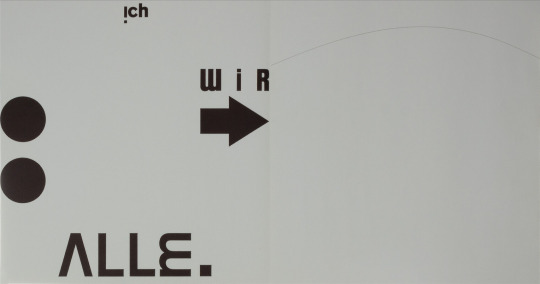
Wolfgang Weingart, ich-WIR-ALLE, (book spread, folded; letterpress), 1971 [Flat & Bound, Integral Lars Müller, Zürich]
49 notes
·
View notes